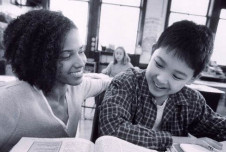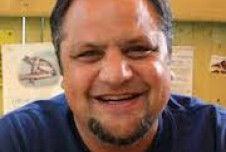I sat across the table from Dawn, a wide-eyed eight-year-old girl in pigtails, bracing myself to tell her the news.

I have told students they have a learning disability hundreds of times over my 20 years as a school psychologist. But there was something about her earnest and expectant face that made me pause.
Was giving her an official label going to make her feel stigmatized and defeated?
Would the benefits of having access to more specialized services outweigh the cost to her academic self-esteem?
I carefully explained how her brain worked with a visual aid of her brain in pictures. I told her where she was strong and where she needed to do “brain pushups” to get stronger. And I told her that she had something called “dyslexia.”
And she jumped out of her chair, smiled ear to ear, screamed “YES!,” and did a move I’ve seen in sports celebrations many times—the signature victory arm pump.
Wait, what?
As it turns out, I had also tested her brother a few years before, and he had dyslexia, too. He had told her that knowing he had dyslexia made him not feel stupid, and that it really helped his teachers understand how his brain worked differently. Dawn told me, “So this means I’m not dumb!”
According to labeling theory, when you label a student with a learning disability, this creates a problem—they hold lower expectations for themselves and others hold lower expectations of them. In turn, the student may live up to these low expectations. However, the research supporting this claim is controversial. Although students with learning disabilities do tend to struggle with lower achievement and hold negative beliefs about their academic abilities, some researchers point out that it is difficult to disentangle what is causing these challenges. It gets murky—would Dawn be behind her classmates in reading because she has dyslexia, because she doesn’t have access to high-quality support programs, or because her teachers and parents now hold lower expectations for her?
We don’t really know. But the reality is that, in our public schools, access to special services sometimes depends upon having a diagnosis or label—and it’s possible that the way we treat students with these labels is holding them back. Here are several research-backed tips for educators and parents to reduce the negative effects of labels and the stigma around them.
1. Don’t focus on the labels
Language is powerful. Even a subtle shift in language can influence how students see themselves and how stigmatized they feel. A 2018 article by researcher Mark Weist and his colleagues offers a number of suggestions for reducing the stigma of labels:
- When a label is required, describe to the student why labels are used. For example, “Labels help us understand why reading is hard for you and what the research says about how to help. Labels can also give you more specific help that you might not be able to get without the label. But we are all going to focus on what we are going to do to help, not what we call it.”
- Use person-centered language. Instead of referring to a student as a “dyslexic student,” refer to them as “a student with dyslexia.”
- When possible, especially with younger students, use less stigmatizing language in describing their challenges (e.g., “learning differences” versus “learning disorder” or “severe dyslexia”).
By using this language, we’re trying to prevent students from overidentifying with their challenges and weaknesses.
2. Focus on the “sea of strengths” around the “islands of weakness”
What if you were defined only by your greatest weakness? Focusing on strengths isn’t just a nice thing to do; it’s essential for students with learning disabilities (and all students) to feel good about themselves as learners.
Renowned dyslexia expert Sally Shaywitz of the The Yale Center for Dyslexia & Creativity coined this phrase: “Dyslexia is an island of weakness surrounded by a sea of strengths.” When students see their weaknesses as “islands,” their challenges become more specific and manageable (e.g., “I need help figuring out long words”) rather than global and difficult to tackle (e.g., “I am not good at reading”).
Using specific language can also foster a “growth mindset” more conducive to learning. Rather than thinking, “I don’t have a math brain because I have dyscalculia,” students might say, “I need to do brain pushups in math.” The same goes for adults when we talk about students; instead of saying, “He has a major reading and learning deficit,” we can make it more specific and manageable by saying, “He has areas of strength and weakness in learning to read that we can address through phonics instruction.”
Research is also emerging on the sea of “hidden strengths” of students with dyslexia and other learning disabilities:
- Strong visual-spatial thinking and skill in figuring out patterns
- The ability to make unique associations between concepts
- Strengths in seeing the “big picture” and creative problem solving
As educators and parents, we can highlight these strengths with students like Dawn (who, incidentally, scored off the charts on tests of visual logic puzzles). Indeed, all students would profit from having a spotlight on their unique talents and skills and not just on their core weaknesses.
“Often times we focus on the difficulties, but they have these incredible superpowers,” says psychologist Tracy Alloway, whose new children’s book series turns children’s learning disabilities into superpowers. Bringing those “superpowers” to the front of the discussion is a tool for empowering those with learning disabilities and helping other children appreciate their classmates’ unique talents, as well.
3. Foster self-awareness and self-advocacy skills
Not only can we focus on the extraordinary strengths these students already have, but we can also help them cultivate other strengths they’ll need to be successful.
Being diagnosed with a learning disability does not have to resign students to a life of struggle, frustration, and poor achievement. In a 30-year study by the Frostig Center, students with learning disabilities did better in their academic and personal lives if they had these six skills and resources:
- Self-awareness: Recognizing their unique talents and accepting their challenges.
- Proactivity: Believing in the power to make changes, taking responsibility for their actions, making decisions and acting upon them.
- Perseverance: Learning from hardships and not giving up when tasks get hard.
- Goal setting: Making realistic and attainable goals, taking into account strengths and areas of need.
- Support systems: Identifying people who can provide support and actively seeking out support.
- Emotional coping strategies: Recognizing stress triggers for learning difficulties and developing effective means of coping with them.
As parents and educators, we would be well-served to focus on cultivating these social-emotional and behavioral skills so that students with learning disabilities can emerge from their educational experience with success in school and life.
Several researchers offer practical ways to support these resilience skills, using brain-based research. In their book The Yes Brain: How to Cultivate Courage, Curiosity, and Resilience in Your Child, psychotherapists Dan Siegel and Tina Payne Bryson share how parents and educators can help students strengthen their sense of balance, resilience, insight, and empathy. This “balanced brain” helps students with different learning profiles think more flexibly, be more willing to take chances and make mistakes, and manage adversity and big feelings. All of these traits are essential for learners, especially those who have additional frustration due to the challenges of their learning differences.
Tapping into our students’ potential
At home and in the classroom, educators and parents can easily get tripped up on the language to use with students with learning disabilities. Having a strength-based lens and a few scripts ready can make a big difference in how the students we interact with see themselves as learners.
We could all take a lesson from my student, Dawn, on positive mindset. When I later shared Dawn’s reaction to being diagnosed with dyslexia with her mother, we both teared up a little. Dawn gave me hope that as educators and parents, we can cultivate that resilience and strength in all the students who come to us with diverse learning needs.








Comments